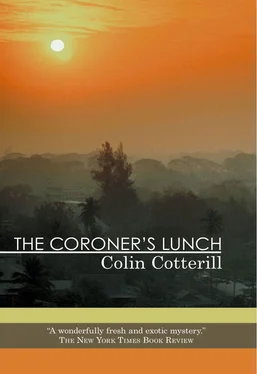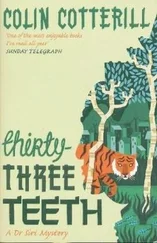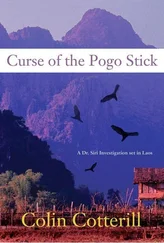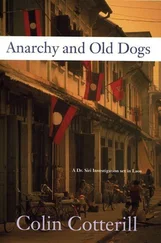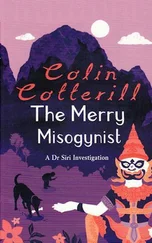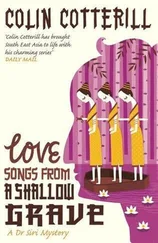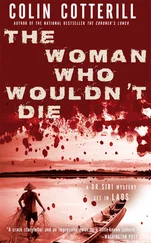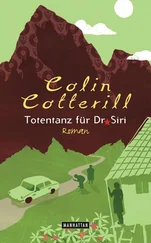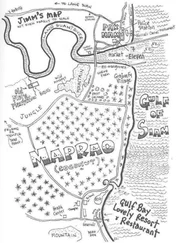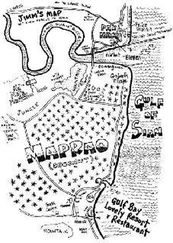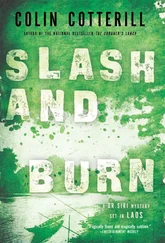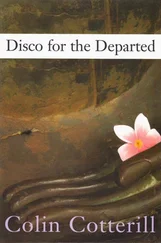Colin Cotterill - The Coroner's lunch
Здесь есть возможность читать онлайн «Colin Cotterill - The Coroner's lunch» весь текст электронной книги совершенно бесплатно (целиком полную версию без сокращений). В некоторых случаях можно слушать аудио, скачать через торрент в формате fb2 и присутствует краткое содержание. Жанр: Криминальный детектив, на английском языке. Описание произведения, (предисловие) а так же отзывы посетителей доступны на портале библиотеки ЛибКат.
- Название:The Coroner's lunch
- Автор:
- Жанр:
- Год:неизвестен
- ISBN:нет данных
- Рейтинг книги:3 / 5. Голосов: 1
-
Избранное:Добавить в избранное
- Отзывы:
-
Ваша оценка:
- 60
- 1
- 2
- 3
- 4
- 5
The Coroner's lunch: краткое содержание, описание и аннотация
Предлагаем к чтению аннотацию, описание, краткое содержание или предисловие (зависит от того, что написал сам автор книги «The Coroner's lunch»). Если вы не нашли необходимую информацию о книге — напишите в комментариях, мы постараемся отыскать её.
The Coroner's lunch — читать онлайн бесплатно полную книгу (весь текст) целиком
Ниже представлен текст книги, разбитый по страницам. Система сохранения места последней прочитанной страницы, позволяет с удобством читать онлайн бесплатно книгу «The Coroner's lunch», без необходимости каждый раз заново искать на чём Вы остановились. Поставьте закладку, и сможете в любой момент перейти на страницу, на которой закончили чтение.
Интервал:
Закладка:
“Is Comrade Kham’s wife here by herself?”
“Yes.”
“Then do you think you could bring her just one glass of ice water? It’s a hot day.”
“I can do that.”
He loped off toward the canteen, and Siri slowed down. He wanted to second-guess Mrs. Nitnoy’s purpose for coming here. Her visits invariably spelled trouble, although he couldn’t recall doing anything wrong of late. She was a strong, loud woman with a large, menacing chest and hips that rolled at you like tank treads. She was a senior cadre at the Women’s Union and carried as much weight politically as she did structurally. Above all else, she was a stickler for rules.
“It has to be the shoes,” he thought. Judge Haeng had reported his disobedience, and he’d called in the big gun. She was here to force his feet into sweaty vinyl shoes that would leave him crippled. She’d be sitting at his desk watching the clock to see how late he was getting back from lunch. She’d be superficially jolly and shake his hand and ask after his health, and then humiliate him.
He was feeling sick to his stomach when he walked under the MORGUE sign. He stood at the door to his office and counted to three before confidently striding in. Dtui was alone at her desk reading something she hurriedly stuffed into a drawer.
“Mrs. Nitnoy?”
“In the freezer.”
His face went blank and his mind followed. “Wha-?”
“They brought her in just after you left for lunch.”
“What happened to her?” He sat heavily on his squeaky chair.
“She died.”
“Well, I’d hope so if she’s in the freezer. What did she die of?”
She looked up at him and, predictably, smiled. “I’m a nurse. You’re a coroner. Isn’t that what you’re supposed to tell us ?”
“Could you perhaps give me a start? Who brought her in? What did they say?”
“Two drivers from the Women’s Union. They said she was sitting having lunch, dribbled a little bit, and keeled over. They checked her pulse and she was dead. The Union doctor told them to bring her here as it was a…what do you call it? It was an unnatural death.”
Siri was disturbed to find that his first feeling wasn’t of compassion for the poor woman, but of relief that he didn’t have to wear vinyl shoes. His second feeling was anxiety. This, after ten months, would be his first high-profile case. A lot of senior party people would be looking over his shoulder. He pondered the possible consequences.
“Does Comrade Kham know?”
“He’s in Xiang Khouang. They phoned him. He said go ahead with the autopsy. He’s flying back this evening.”
“I suppose we should get on with it, then.” He stood, took a deep breath, and walked through to the examination room. Mr. Geung was already in there, standing in front of the freezer, rocking anxiously, a glass of ice water in one hand, a tissue in the other.
It was about four-thirty by the time all the textbook procedures were completed. She’d been measured, but not weighed because they didn’t have a scale. Earlier in the year, they’d experimented with two bathroom scales. Siri and Geung weighed themselves on each, then held up the corpse between them. Due to some obscure law of physics, the body only ever weighed half of what it should have. So they abandoned weighing altogether.
At one point, Siri leaned over the woman’s face. He called to Geung.
“Mr. Geung. Your nose is better than mine. What do you smell here?”
Geung didn’t need to lean. He’d smelled it already.
“Balm.”
“Very good. Let’s get the old girl undressed, shall we?”
“And nuts.”
“What?”
“Balm and nuts. I…I smell nuts.”
Siri didn’t smell the nuts or know what Geung was talking about, but he got Dtui to note it down anyway.
Once Mrs. Nitnoy’s clothes had been inspected and bagged, the body was photographed. The hospital budget allowed one roll of color film per seven bodies, which meant one full-body front, one full-body back, one topical specific to the area of cause. The one or two leftover shots were technically for contentious areas of the anatomy, but often got used up on group photographs of nurses who wanted to send them back to their families in the countryside.
On either side of Mrs. Nitnoy’s formidable chest, Dr. Siri made incisions that came together at the base of her sternum and ran down to her pubic bone. Thus the autopsy began. Everything he did, he explained very slowly, because Dtui had to write it all down in the notebook, and she didn’t take shorthand.
Siri used the old bone cutters to get through her rib cage and, one by one, he described, weighed, and labeled the organs, and Dtui jotted down irregularities in her book. Siri then used a fine scalpel to define the scalp, which he pulled forward over poor Mrs. Nitnoy’s face. While he began a more detailed inspection of the organs at the examination bench, Mr. Geung set about the cranium.
Although a requisition was in for an electric saw and the hospital board was considering it, in the meantime they had no choice but to use a hacksaw. It was the department’s good fortune that sawing was one of Mr. Geung’s superior skills. With his tongue poking from the corner of his mouth, he painstakingly and expertly cut deep enough to penetrate the skull, but not so deep as to damage the brain. It was a skill Siri had been unable to master.
The morgue at the end of 1976 was hardly better equipped than the meatworks behind the morning market. For his own butchery, Siri had blunt saws and knives, a bone cutter, and drills inherited from the French. He had his personal collection of more delicate scalpels and other instruments. There were one or two gauges and drips and pipettes and the like, but there was no laboratory. The closest was forty kilometers away, across the border in Udon Thani, and the border was closed to the dreaded communist hordes.
There was an old microscope Siri had requisitioned from the stores at Dong Dok pedagogical institute. If they ever reopened the science department, it would likely be missed. Even though the microscope was an ancient relic of bygone biologists and should have been in a museum, it still magnified beautifully. It was just that the slide photographs in his old textbooks were so blurred, he couldn’t always tell what he was looking for.
Most of the results from Siri’s morgue relied on archaic color tests: combinations of chemicals or litmus samples. These were more suitable for telling what wasn’t, rather than what was. Assuming the necessary chemicals were available at Lycee Vientiane’s chemistry department, Siri could usually eliminate fifty possible causes of death, but still be left with a hundred and fifty others.
So it was hardly surprising, when four-thirty came around, that he hadn’t the foggiest idea what had killed Mrs. Nitnoy. He could give a list as long as your distal tibia of things that hadn’t. She hadn’t been hit by a train (as there were none in Laos). She hadn’t been shot, stabbed, suffocated, or had her limbs severed by an army launch. But as she’d been in a crowded room when she died, these were no great discoveries.
Some witnesses said she’d choked on her food, but the absence of any in her esophagus and the abruptness of her death said otherwise. Without a lab, it was next to impossible to check for poison unless you knew which it was, and as the lady had been eating from a communal table it was quite unlikely she alone would have died.
In the absence of Judge Haeng and his helpful advice, Siri had taken particular pains to establish that she hadn’t died from a heart attack. There was no evidence of an occlusion or thrombosis.
He’d read about forensic scientists around the world who reveled in mysteries such as these. He wasn’t yet one of them.
Читать дальшеИнтервал:
Закладка:
Похожие книги на «The Coroner's lunch»
Представляем Вашему вниманию похожие книги на «The Coroner's lunch» списком для выбора. Мы отобрали схожую по названию и смыслу литературу в надежде предоставить читателям больше вариантов отыскать новые, интересные, ещё непрочитанные произведения.
Обсуждение, отзывы о книге «The Coroner's lunch» и просто собственные мнения читателей. Оставьте ваши комментарии, напишите, что Вы думаете о произведении, его смысле или главных героях. Укажите что конкретно понравилось, а что нет, и почему Вы так считаете.
